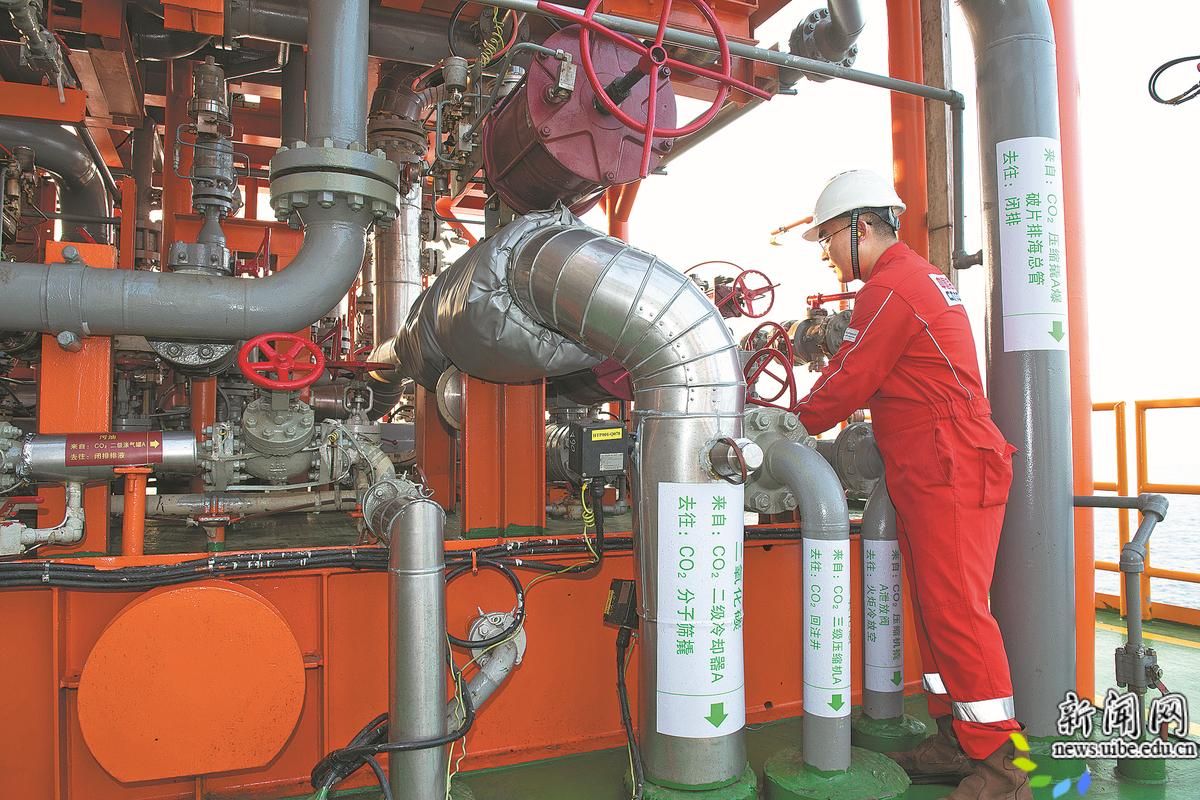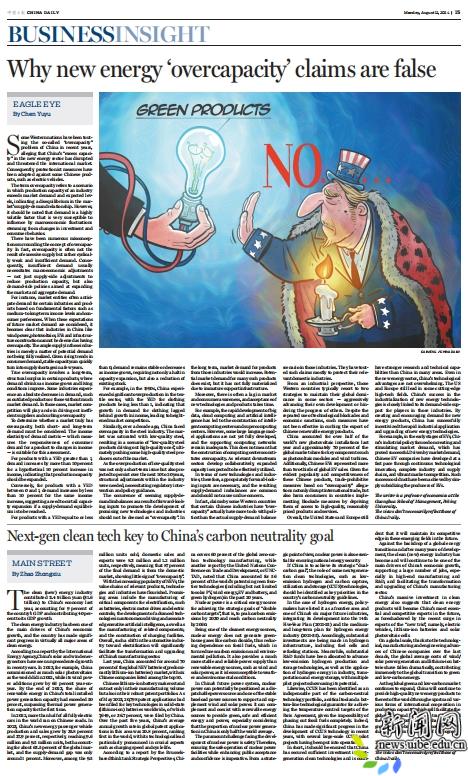(来源:《China Daily》 2024-08-12)
 An employee operates carbon capture, utilization and storage (CCUS) equipment at a platform off Guangdong province in May 2023. MAO SIQIAN/XINHUA
An employee operates carbon capture, utilization and storage (CCUS) equipment at a platform off Guangdong province in May 2023. MAO SIQIAN/XINHUA
The clean (new) energy industry contributed 11.4 trillion yuan ($1.6 trillion) to China's economy last year, accounting for 9 percent of the country's GDP and contributing 40 percent to its GDP growth.
The clean energy industry has been one of the main drivers of China's economic growth, and the country has made significant progress in virtually all major areas of clean energy.
According to a report by the International Energy Agency, China's solar and wind energy sectors have seen unprecedented growth in recent years. In 2023, for example, China commissioned as much solar photovoltaics as the world did in 2022, while its wind power additions grew by 66 percent year-on-year. By the end of 2023, the share of renewable energy in China's total installed power generation capacity had exceeded 50 percent, surpassing thermal power generation capacity for the first time.
In 2022, more than half of all fully electric cars in the world ran on Chinese roads. In 2023, China's new energy passenger vehicle production and sales grew by 35.8 percent and 37.9 percent, respectively, reaching 9.6 million and 9.5 million units, both accounting for about 63.5 percent of the global market, and the supply-demand gap was only around 1 percent. Moreover, among the 9.5 million units sold, domestic sales and exports were 8.3 million and 1.2 million units, respectively, meaning that 87 percent of the final demand is from the domestic market, showing little sign of "overcapacity".
With the increasing popularity of NEVs, the value chains of relevant products, technologies and industries have flourished. Promising areas include the manufacturing of critical components for electrification, such as batteries, electric motor drives and electric controls; the development of advanced technologies in autonomous driving and associated generative artificial intelligence, as well as the manufacturing of related components; and the construction of charging facilities. Overall, such a shift in the automotive industry toward electrification will significantly facilitate the transformation and upgrading of China's manufacturing sector.
Last year, China accounted for around 70 percent of the global NEV batteries (predominantly lithium-ion batteries) market, with six Chinese companies listed among the top 10.
Chinese lithium-ion battery makers stand out not only in their manufacturing volume but also in their robust patent portfolios. As of May 2023, 20,798 patent applications had been filed for key technologies in solid-state (lithium-ion) batteries worldwide, of which 7,649, or 36.7 percent, were filed by China. Over the past five years, China's average annual growth rate in global patent applications in this area was 20.8 percent, ranking first in the world, with its technological lead particularly pronounced in crucial aspects such as charging speed and cycle life.
According to a report by the Brussels-based think tank Strategic Perspectives, China covers 60 percent of the global zero-carbon technology manufacturing, while another report by the United Nations Conference on Trade and Development, or UNCTAD, noted that China accounted for 56 percent of the world's patents in green frontier technologies (including but not limited to solar PV, wind energy, EV and battery, and green hydrogen) in the past 20 years.
Nuclear power is a critical energy source for achieving the strategic goals of "double carbon targets", that is, to peak carbon emissions by 2030 and reach carbon neutrality by 2060.
Being one of the cleanest energy sources, nuclear energy does not generate greenhouse gases like carbon dioxide, thus reducing dependence on fossil fuels, which in turn reduces carbon emissions and environmental pollution. It also provides a much more stable and reliable power supply than renewable energy sources, such as wind and solar power, as it is less susceptible to weather and environmental conditions.
In China's future power system, nuclear power can potentially be positioned as a dispatchable power source and one of the stable baseload power sources to support and supplement wind and solar power. It can complement and coexist with renewable energy sources to provide green, safe and efficient energy and power, especially considering that the proportion of nuclear power generation in China is only half the world average.
The paramount challenge facing the development of nuclear power is safety. Therefore, ensuring the safe operation of nuclear power facilities while enhancing public acceptance and confidence is imperative. From a strategic point of view, nuclear power is also essential for ensuring national energy security.
If China is to achieve its strategic "dual-carbon goal", the role of some next-generation clean technologies, such as low-emission hydrogen and carbon capture, utilization and storage (CCUS) technologies, should be identified as key priorities in the country's carbon neutrality guidelines.
In the case of hydrogen energy, policymakers have listed it as a frontier area and one of China's six major future industries, integrating its development into the 14th Five-Year Plan (2021-25) and the medium- and long-term plan for hydrogen energy industry (2021-35). Accordingly, substantial investments are being made in hydrogen infrastructure, including fuel cells and refueling stations. Meanwhile, substantial R&D funds have been allocated to advance low-emission hydrogen production and storage technologies, as well as the application of hydrogen energy in industry, transportation and energy storage, with multiple pilot projects showcasing its potential.
Likewise, CCUS has been identified as an indispensable part of the carbon-neutral technology portfolio, a critical tool and a bottom-line technological guarantor for achieving the temperature control targets of the Paris Agreement, given the impossibility of phasing out fossil fuels completely. Indeed, China has made significant progress in the development of CCUS technology in recent years, with several large-scale CCUS pilot projects having been put into operation.
In short, it should be ensured that China has secured sufficient investment in next-generation clean technologies and is confident that it will maintain its competitive edge in these emerging fields in the future.
Against the backdrop of a global energy transition and after many years of development, the clean (new) energy industry has become and will continue to be one of the main drivers of China's economic growth, supporting a large number of jobs, especially in high-end manufacturing and R&D, and facilitating the transformation and upgrading of China's manufacturing sector.
China's massive investment in clean energy also suggests that clean energy products will become China's most essential and competitive exports in the future, as foreshadowed by the recent surge in exports of the "new trio", namely, electric vehicles, lithium-ion batteries and solar photovoltaic cells.
On a global scale, thanks to the technological, manufacturing and engineering advances of Chinese companies over the last decade, the global average costs of wind/solar power generation and lithium-ion batteries have fallen dramatically, contributing immensely to the global transition to green and low-carbon energy.
As the global green and low-carbon market continues to expand, China will continue to provide high-quality new energy products to the rest of the world through exports and various forms of international cooperation in production capacity, which will facilitate the global green and low-carbon transition and the fight against climate change, export growth and jobs to other economies, and share with them the benefits of its progress.
The writer is president of the University of International Business and Economics.

附原文链接:
https://www.chinadaily.com.cn/a/202408/12/WS66b9769fa3104e74fddb9898.html
https://enapp.chinadaily.com.cn/a/202408/12/AP66b976a2a310f09f572e2785.html